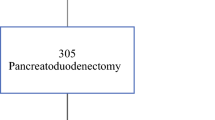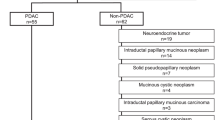Abstract
Background
Postoperative pancreatic fistula (POPF) is one of the most common and clinically relevant complications after distal pancreatectomy (DP), occurring in 5–40% of patients. Determining risk factors for this complication may aid in its prevention. This study sought to predict the development of POPF after DP preoperatively and objectively based on radiologic findings.
Methods
This study included 60 patients who underwent DP using a stapler for pancreatic division between June 2011 and January 2013. Fatty infiltration, apparent diffusion coefficients (ADC) on preoperative MRI, pathologic fat, and fibrosis were measured. Pancreatic thickness and cross-sectional area of the pancreas stump on CT scan were also measured.
Results
Mean patient age was 60.5 years, 26 patients (46.3%) had pancreatic cancer and 20 (33.3%) underwent laparoscopic surgery. Clinically relevant POPF was observed in 12 patients (20.0%). Linear regression analysis showed a significant correlation between fat quantification on MRI and pathologic fat (pathologic fat = 1.978 × MR fat −6.393, p < 0.001, R 2 = 0.777). Univariate analysis showed that ≤8% fat on MRI (p = 0.040), ≤5% pathologic fat (p = 0.002), ADC ≤ 1.3 × 10−3 mm2/s (p = 0.020), thicker pancreas (p = 0.007), and wider cross-sectional area of the pancreas (p = 0.013) were significantly associated with clinically relevant POPF after DP. Multivariate analysis revealed that pancreas thickness >17.6 mm [odds ratio (OR) 6.532, p = 0.064] and cross-sectional area >377 mm2 (OR 12.676, p = 0.052) were marginally related to clinically relevant POPF.
Conclusions
Pancreatic thickness and cross-sectional area of the transected surface of the pancreas are marginally significant risk factors for POPF development after DP. Measuring pancreatic thickness and cross-sectional area can be a promising tool for the preoperative prediction of POPF.





Similar content being viewed by others
References
Sugimoto M, Gotohda N, Kato Y et al (2013) Risk factor analysis and prevention of postoperative pancreatic fistula after distal pancreatectomy with stapler use. J Hepatobiliary Pancreat Sci 20:538–544
Lillemoe KD, Cameron JL, Kim MP et al (2004) Does fibrin glue sealant decrease the rate of pancreatic fistula after pancreaticoduodenectomy? Results of a prospective randomized trial. J Gastrointest Surg 8:766–772
Misawa T, Shiba H, Usuba T et al (2008) Safe and quick distal pancreatectomy using a staggered six-row stapler. Am J Surg 195:115–118
Frymerman AS, Schuld J, Ziehen P et al (2010) Impact of postoperative pancreatic fistula on surgical outcome–the need for a classification-driven risk management. J Gastrointest Surg 14:711–718
Pedrazzoli S, Liessi G, Pasquali C et al (2009) Postoperative pancreatic fistulas: preventing severe complications and reducing reoperation and mortality rate. Ann Surg 249:97–104
Hashimoto Y, Traverso LW (2012) After distal pancreatectomy pancreatic leakage from the stump of the pancreas may be due to drain failure or pancreatic ductal back pressure. J Gstrointest Surg 16:993–1003
Kawai M, Tani M, Okada K et al (2013) Stump closure of a thick pancreas using stapler closure increases pancreatic fistula after distal pancreatectomy. Am J Surg 206:352–359
Kah Heng CA, Salleh I, San TS et al (2010) Pancreatic fistula after distal pancreatectomy: incidence, risk factors and management. ANZ J Surg 80:619–623
Ridolfini MP, Alfieri S, Gourgiotis S et al (2007) Risk factors associated with pancreatic fistula after distal pancreatectomy, which technique of pancreatic stump closure is more beneficial? World J Gastroenterol 13:5096–5100
Callery MP, Pratt WB, Kent TS et al (2013) A prospectively validated clinical risk score accurately predicts pancreatic fistula after pancreatoduodenectomy. J Am Coll Surg 216:1–14
Mathur A, Pitt HA, Marine M et al (2007) Fatty pancreas: a factor in postoperative pancreatic fistula. Ann Surg 246:1058–1064
Wellner UF, Kayser G, Lapshyn H et al (2010) A simple scoring system based on clinical factors related to pancreatic texture predicts postoperative pancreatic fistula preoperatively. HPB 12:696–702
Kiyochi H, Matsukage S, Nakamura T et al (2015) Pathologic assessment of pancreatic fibrosis for objective prediction of pancreatic fistula and management of prophylactic drain removal after pancreaticoduodenectomy. World J Surg 39:2967–2974
Yardimci S, Kara YB, Tuney D et al (2015) A simple method to evaluate whether pancreas texture can be used to predict pancreatic fistula risk after pancreatoduodenectomy. J Gastrointest Surg 19:1625–1631
Sugimoto M, Takahashi S, Gotohda N et al (2013) Schematic pancreatic configuration: a risk assessment for postoperative pancreatic fistula after pancreaticoduodenectomy. J Gastrointest Surg 17:1744–1751
Roberts KJ, Hodson J, Mehrzad H (2014) A preoperative predictive score of pancreatic fistula following pancreatoduodenectomy. HPB 16:620–628
Sandini M, Bernasconi DP, Ippolito D et al (2015) Preoperative computed tomography to predict and stratify the risk of severe pancreatic fistula after pancreatoduodenectomy. Medicine 94:e1152
Kirihara Y, Takahashi N, Hashimoto Y et al (2013) Prediction of pancreatic anastomotic failure after pancreatoduodenectomy: the use of preoperative, quantitative computed tomography to measure remnant pancreatic volume and body composition. Ann Surg 257:512–519
Frozanpor F, Loizou L, Ansorge C et al (2014) Correlation between preoperative imaging and intraoperative risk assessment in the prediction of postoperative pancreatic fistula following pancreatoduodenectomy. World J Surg 38:2422–2429
Frozanpor F, Loizou L, Ansorge C et al (2012) Preoperative pancreas CT/MRI characteristics predict fistula rate after pancreaticoduodenectomy. World J Surg 36:1858–1865
Kanda M, Fujii T, Suenaga M et al (2013) Estimated pancreatic parenchymal remnant volume accurately predicts clinically relevant pancreatic fistula after pancreatoduodenectomy. Surgery 156:601–610
Lee SE, Jang JY, Lim CS et al (2010) Measurement of pancreatic fat by magnetic resonance imaging: predicting the occurrence of pancreatic fistula after pancreatoduodenectomy. Ann Surg 251:932–936
Bassi C, Dervenis C, Butturini G et al (2005) Postoperative pancreatic fistula: an international study group (ISGPF) definition. Surgery 138:8–13
Yoon JH, Lee JM, Lee BK et al (2016) Pancreatic steatosis and fibrosis: quantitative assessment with preoperative multiparametric MR imaging. Radiology 279:140–150
Muraoka N, Uematsu H, Kimura H et al (2008) Apparent diffusion coefficient in pancreatic cancer: characterization and histopathological correlations. J Magn Reson Imaging 27:1302–1308
Katz DS, Hines J, Math KR et al (1999) Using CT to reveal fat-containing abnormalities of the pancreas. AJR Am J Roentgenol 172:393–396
Kovanlikaya A, Mittelman SD, Ward A et al (2005) Obesity and fat quantification in lean tissues using three-point Dixon MR imaging. Pediatr Radiol 35(6):601–607
Rosso E, Casnedi S, Pessaux P et al (2009) The role of “fatty pancreas” and of BMI in the occurrence of pancreatic fistula after pancreaticoduodenectomy. J Gastrointest Surg 13:1845–1851
Gaujoux S, Cortes A, Couvelard A et al (2010) Fatty pancreas and increased body mass index are risk factors of pancreatic fistula after pancreaticoduodenectomy. Surgery 148:15–23
Jimenez RE, Hawkins WG (2012) Emerging strategies to prevent the development of pancreatic fistula after distal pancreatectomy. Surgery 152:S64–S70
Harada N, Ishizawa T, Inoue Y et al (2014) Acoustic radiation force impulse imaging of the pancreas for estimation of pathologic fibrosis and risk of postoperative pancreatic fistula. J Am Coll Surg 219:887–894
Ichikawa T, Haradome H, Hachiya J et al (1999) Diffusion-weighted MR imaging with single-shot echo-planar imaging in the upper abdomen: preliminary clinical experience in 61 patients. Abdom Imaging 24:456–461
Sener RN (2001) Diffusion MRI: apparent diffusion coefficient (ADC) values in the normal brain and a classification of brain disorders based on ADC values. Comput Med Imaging Graph 25:299–326
Watanabe H, Kanematsu M, Tanaka K et al (2014) Fibrosis and postoperative fistula of the pancreas: correlation with MR imaging findings-preliminary results. Radiology 270:791–799
Frozanpor F, Albiin N, Linder S et al (2010) Impact of pancreatic gland volume on fistula formation after pancreatic tail resection. JOP 11:439–443
Okano K, Oshima M, Kakinoki K et al (2013) Pancreatic thickness as a predictive factor for postoperative pancreatic fistula after distal pancreatectomy using an endopath stapler. Surg Today 43:141–147
Van Hoe L, Van Cutsem E, Vergote I et al (1997) Size quantification of liver metastases in patients undergoing cancer treatment: reproducibility of one-, two-, and three-dimensional measurements determined with spiral CT. Radiology 202:671–675
Acknowledgements
The authors appreciate Jeong Hee Yoon, MD (Department of Radiology, Seoul National University Hospital, Republic of Korea) for the radiologic review and significant contribution of the revision of the manuscript. The authors appreciate Jeong Min Lee, MD (Department of Radiology, Seoul National University Hospital, Republic of Korea) and Stephan Kannengiesser, PhD (Siemens Healthineers, Germany) for the sequence and software validation.
Author information
Authors and Affiliations
Corresponding author
Ethics declarations
Conflict of interest
The authors declare that they have no conflicts of interest.
Additional information
Ye Rim Chang and Jae Seung Kang have contributed equally to this study.
Rights and permissions
About this article
Cite this article
Chang, Y.R., Kang, J.S., Jang, JY. et al. Prediction of Pancreatic Fistula After Distal Pancreatectomy Based on Cross-Sectional Images. World J Surg 41, 1610–1617 (2017). https://doi.org/10.1007/s00268-017-3872-3
Published:
Issue Date:
DOI: https://doi.org/10.1007/s00268-017-3872-3




